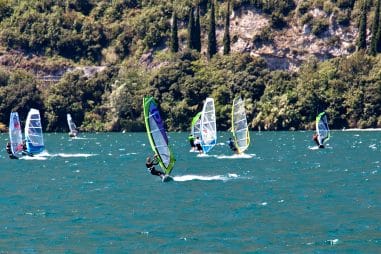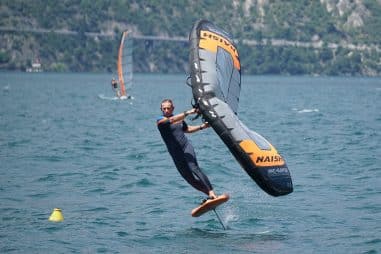Windsurfing is one sport that you need to learn well before you get started on it. It can get very physical and without the proper guidance from a certified instructor, it can easily go sideways. Make sure to learn everything there is to know about windsurfing including speed.
What Is a Good Wind Speed for Windsurfing?
You don’t need very much wind for windsurfing because as long as you can feel some wind around, you’d be able to successfully move your windsurf. 8 kilometers per hour or 5 miles per hour is a good enough wind speed that even beginner windsurfers can maneuver.
Intermediate to advanced windsurfers can take on more speed since they are more trained and skilled to move their windsurfer.
What Is the Best Wind Speed for Windsurfing?
The best wind speed may vary from person to person, skill to skill, and equipment to equipment. While advanced windsurfers can take on extreme winds of 35 miles per hour or more, beginners should only get on their windsurfers if the wind is below 15 miles per hour. Any faster and they will have a hard time controlling their windsurfer.
It is always best to go and try to ride your windsurfer only if you know that you can ride the wind. If you try to ride extreme winds with only a few days of practice, then everything can easily go sideways.
How Does Wind Move a Windsurfer?
Wind direction is something that all windsurfers should understand. The sport is not just as easy as “riding with the wind” or “riding against the wind”. There is a lot that goes into learning the fundamentals of wind directions as this would not only help you sail your windsurfer; it is also guaranteed your safety.
For starters, let’s learn about the basics: downwind and upwind.
- Downwind: Simply put, the downwind is moving in the same direction that the wind is blowing. It is natural that people often ride with the wind as this helps them to be thrust forward.
- Upwind: It is moving opposite the direction that the wind is blowing, the exact opposite of the concept of downwind. While it is generally hard to ride against the wind, windsurfers find that moving their windsurfers upwind is not only possible, but it is also doable but with considerations.
Now that we have covered the basics, let’s talk about the terms that windsurfers often use to depict wind direction.
- Cross Shore Wind: This wind blows directly across the shoreline. There are two kinds of cross shore wind—one that moves from right to left, and the other from left to right. Whether you have a beach start or a water start, cross shore winds make it possible for riders to easily move in and out of the sea.
- Cross Onshore Wind: This wind moves diagonally on the shore at a 45-degree angle. There are also two kinds of cross onshore wind—one that moves diagonally from right to left, and the other from left to right. Beginners in practice often sail in the cross onshore wind as this is considered to be the safest wind condition for the sport.
- Onshore Wind: This is the wind that blows directly from the sea to the shoreline. This is the wind that you can feel against your face if you are looking straight out into the ocean. While onshore wind will not push you out into the water, it gets hard to launch your windsurfer on a water start. This is because the onshore wind will keep your windsurfer from launching out. You would have to be more skilled to be able to launch when an onshore wind is prevailing in your location of choice.
- Cross Offshore Wind: This is the wind that blows diagonally away from the shoreline. The wind also blows at a 45-degree angle coming from the shore and out into the sea. You would need to have a lot of experience to be able to sail out with a prevailing offshore wind. While it’s not impossible to ride in this wind, it can be dangerous, and it can carry you out into the sea pretty quickly without your control. If you are a beginner, it’s best to avoid sailing out in this wind condition.
- Offshore Wind: This is the wind that blows away from the shoreline and out into the sea. Of the five, offshore wind is considered to be the most hazardous and it is recommended to avoid sailing out in this wind condition regardless of your skill level. Both a novice and an advanced windsurfer is no match for this wind.
How Do Windsurfers Go Against the Wind?
We have briefly touched upon the concept of upwind above but to recap, upwind is moving opposite the direction of the wind. In more common terms, it is riding against the wind as opposed to riding with it.
While it can be hard to ride against the wind, it is very doable. Since windsurfers cannot sail against the exact direction the wind is blowing from (this is also called the no-go zone), they go from point A to point B by moving in a zig zag direction from one 45-degree angle from one side to the other 45-degree angle.
To easily understand the 45-degree angle on either side and the no-go zone in the middle, picture a big letter M. The V in the middle is the no-go zone which is the exact direction the wind is blowing from. Remember to never sail straight into this area as you would only come to a dead stop since your sail will not be able to collect any wind.
Now the two lines on either side of the V stand for the 45-degree angles. This is the area where you would perform the zig zag motion to get your windsurfer moving.
Moving upwind can be very tricky and it takes a lot to master it. If you are a beginner, it’s better to learn the basics first (wind direction, board control) before setting out and doing more advanced moves.
How Fast Can You Windsurf?
There are several aspects that can affect how fast you sail your windsurf. These include your skills, weight, your equipment, and the wind direction, among others. On average, a windsurfer can sail as fast as 20 to 25 knots.
If you are an advanced windsurfer you can even sail as fast as 30 to 35 knots. You can go faster, say 45 knots, but this can take a lot of skills (something a beginner should not undertake) and should preferably be done on flat water.
How Do You Windsurf Faster?
If your current speed is not doing it for you, well fret not, because we have several tips on how you can satisfy your need for speed.
- Understand the wind direction: This should be one of the first things that a windsurfer learns. You should be able to know the direction you’ll be sailing through and use this to your advantage. Learn to anticipate the movement of the wind including the shifts, gusts, and lulls.
- Choose your location wisely: If you still won’t go any faster, maybe it’s the condition of the water in your location of choice. Learn to understand the condition of the water because it is always changing. Choose a location with smooth water as this would help you to sail faster.
- Power up: You can’t go fast if you are underpowered so always make sure that you sail powered up. As you improve your skill, try to take on more wind. Challenge yourself but always remember to do it safely.
- Check your gear: If you’re doing everything but you still keep your slow pace then maybe you should pay attention to your gear. Invest in good equipment that will help you go fast.
Can a Windsurfer Go Faster Than the Wind?
It is possible for a windsurfer to go faster than the wind. While you would think that this is all skills, you would be surprised to know that physics plays a big role in this. To understand this, you must first learn the concepts of apparent wind, true wind, and water drag.
It is easy enough to understand the difference between apparent wind and true wind. On the one hand, apparent wind is the wind we feel when we are moving. On the other hand, the true wind is the wind we feel when we are standing still.
You can use the apparent wind to your advantage to make you go faster than the wind. Instead of sailing head on in a straight direction, try to move your windsurfer at an angle to the source of the true wind. The wind on the outside of your sail will move faster, thus, your windsurfer at a speed that is faster than the true wind.
Now that we have sorted that out, we can move on to the concept of water drag and how it can help you ride faster. When you successfully minimize or eliminate water drag by means of planing (the phenomenon that enables the windsurf board to skim across the very top of the water) you can ultimately sail faster than the speed of the wind.
Aside from the scientific concepts that go into moving faster than the wind, there are other things that you can do to help you sail faster than the speed of the wind.
- Choose a board that is lightweight and pair it with a big sail. A big sail can catch more wind and lighter boards need less effort to propel you across the water.
- Choose a board with round edges. If you want to go faster, do not go for boards with sharp edges. Round-edge boards allow more hydrodynamic which translates to an increase in speed.
- Understand the wind direction: Even before you get on the water, test the wind first. We cannot stress this enough, the wind direction of your chosen location can make or break your windsurfing activity







